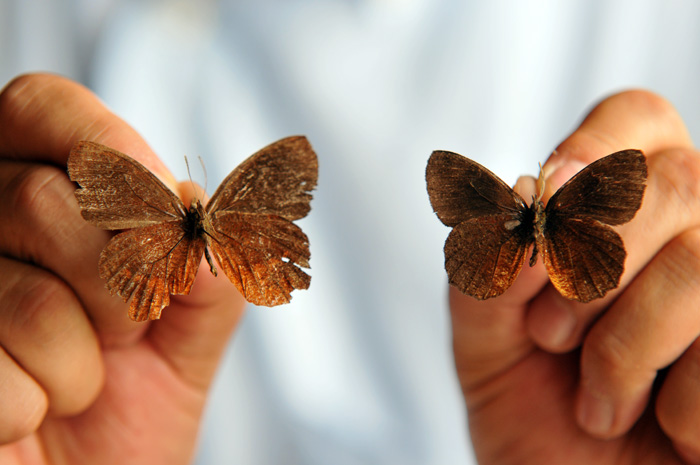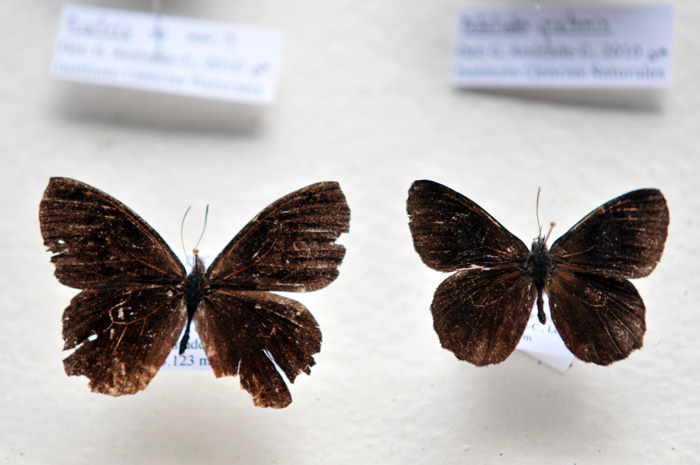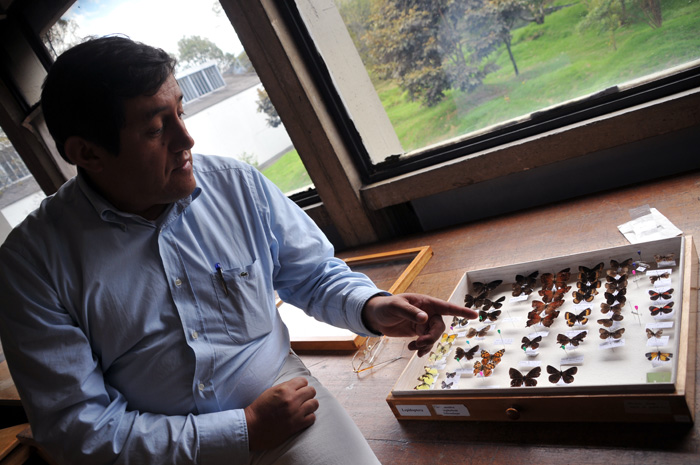They do not have traditional or visible colors, which are typical of Lepidoptera (family to which butterflies are part of), but they are two new important findings for science. Besides, they represent a sample of the favorable environmental conditions that persist in Bogota"s north border; a zone declared a Forest Reserve last July 19th.
These two species are part of the satyrinae subfamily (Nymphalide family), whose most relevant characteristic is the dark color of their wings. They have an enlarged vein on top of their wings that allows them to move and increase their body temperature; something which is very useful if it is consider that they live at highs over 2,600 meters.
They have some yellow stains in the lower back part of their wings that they use as a defense mechanism against other insects; this particular characteristic allows researchers to identify them rapidly.
For living in these conditions, body temperatures higher than 36°C are needed. Due to their dark colors that absorb heat faster and their efficient circulation systems, Satyrinae can resist the cold temperatures of Sabana de Bogotá.
Their main sources of food are Solanaceae and Chusquea leaves, typical in well preserve wastelands.
If it is consider that life length of butterflies varies from 21 days to 8 months, it is possible to say that the species discovered have a medium existence: a blow of life of just two months.
Their function in the ecosystem
"It was an important discovery, because in the limits with Cota, bordering with Mercedes forest and Cerro La Conejera, we found 23 butterfly species. The most shocking and paradoxical thing was that we were very close to the urban area (30 minutes) and we had not been able to identify new species for science", explained researcher Gonzalo Andrade, discoverer of the two Satyrinae.
The butterfly expert of the Institute of Natural Sciences of Universidad Nacional de Colombia found the species in January, 2010, while he was studying the natural characteristics of this area in which the municipalities of Chia and Cota have their borders.
According to professor Andrade, the existence of butterflies in natural scenarios is a bioindicator of the environmental quality of this area in which the butterflies live.
"Male specimens fly long distances to find females for reproduction, while females find better places to spawn. This patter allows determining the environmental quality of the area, since females only lay eggs on plants where caterpillars can eat," described the researcher.
He also mentioned that females have chemical sensors on their legs that allow them to identify the metabolisms produced by nature, their main source of food. "This way, they detect the best conditions to lay eggs, for larvae to be born. In most cases they live in the middle of plants to protect themselves from the weather."
Besides of their importance as environmental indicators, the species discovered play an important role as pollinators of Solanaceae flowers (herbaceous or woody plants) and Chusquea (simular to bamboo)
Now, they are part of the national biodiversity
With 3,274 species, the country is in second place among the nations with the biggest butterfly biodiversity, after Brazil. However, Colombia is in the first place in the world in terms of unique species that only exist in Colombian territory. For now, the registered number is of 350, and this number grows with the discovery of these two new species of Satyrinae.
According to technical requirements, which are giving them a Latin name and assigning taxonomical information, this butterfly could be called "Vanderhammiensis" or something similar, due to the characteristics of the species and the family.
In favor of the reserve
This finding was used as an argument for authorities to manage the declaration of the north border of Bogotá as Forest Reserve, asserted Dalila Camelo, biologist of the Sub direction of Natural Resources of the Autonomous Regional Corporation of Cundinamarca (CAR, for its acronym in Spanish).
"The terrain has the characteristics to preserve and host species despite the contamination issues produced by the city. There, chamelions, lizards, collarejos, hummingbirds, blackbirds, owls, squirrels, bats, among others, can be found. This reaffirms that the capacity of the ecosystem in this area still preserves favorable conditions," mentioned the researcher from CAR.
The Regional Forest Reserve Protector-Producer in the north of Bogotá (as it is officially named) hosts in its territory Torca and Guaymaral wetlands, Conejera hill and wetland and the hydraulig round of Bogotá River.
There are close to 1.500 hectares classified as protected soil that will play the role as migratory route for species and as area of ecological connectivity for the city. If the ecosystem is preserved in the way it is now, these two species of butterfly could be able to continue flying in their natural habitat, and maybe scientist could discover new flying surprises.
 Correo Electrónico
Correo Electrónico
 DNINFOA - SIA
DNINFOA - SIA
 Bibliotecas
Bibliotecas
 Convocatorias
Convocatorias
 Identidad UNAL
Identidad UNAL





